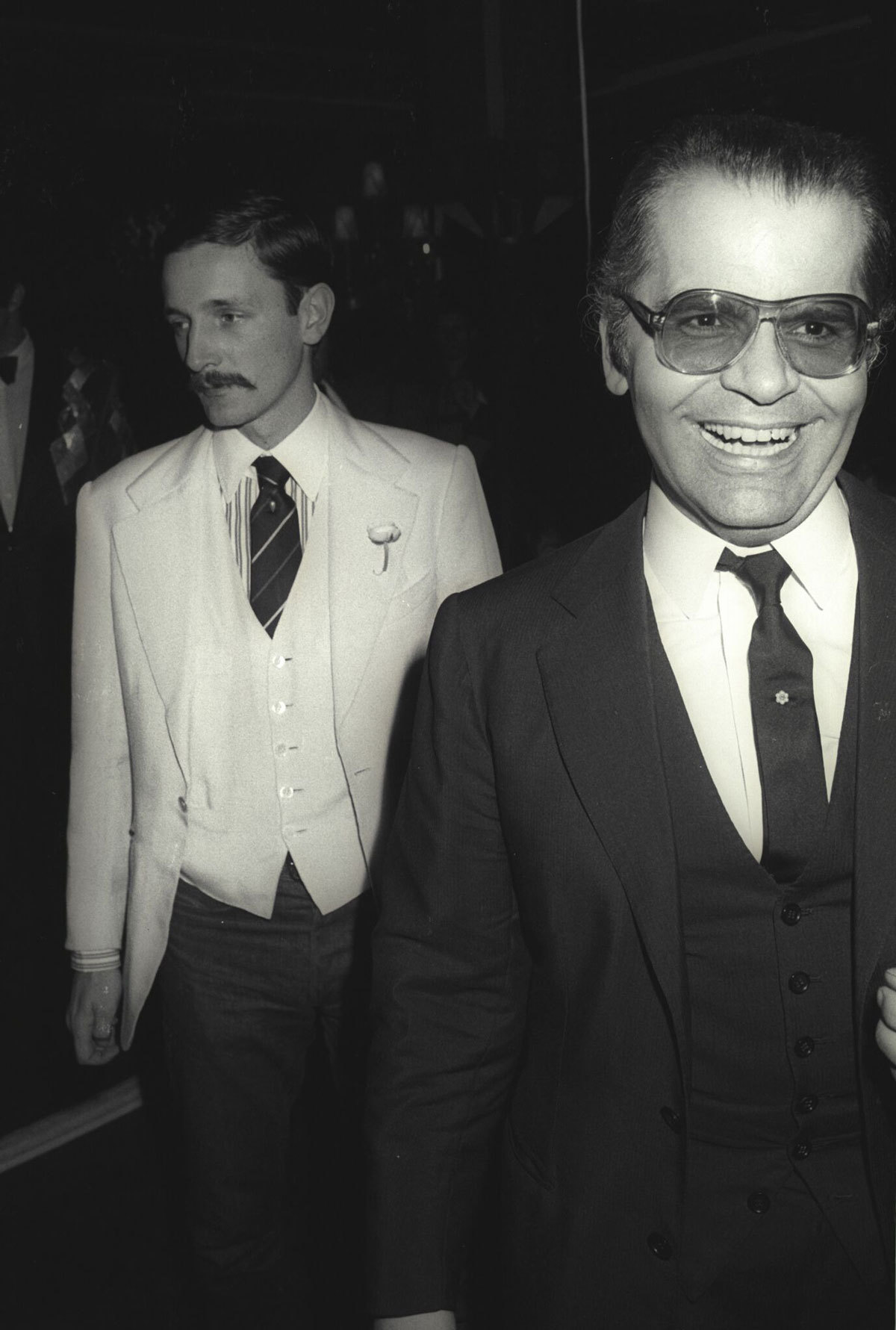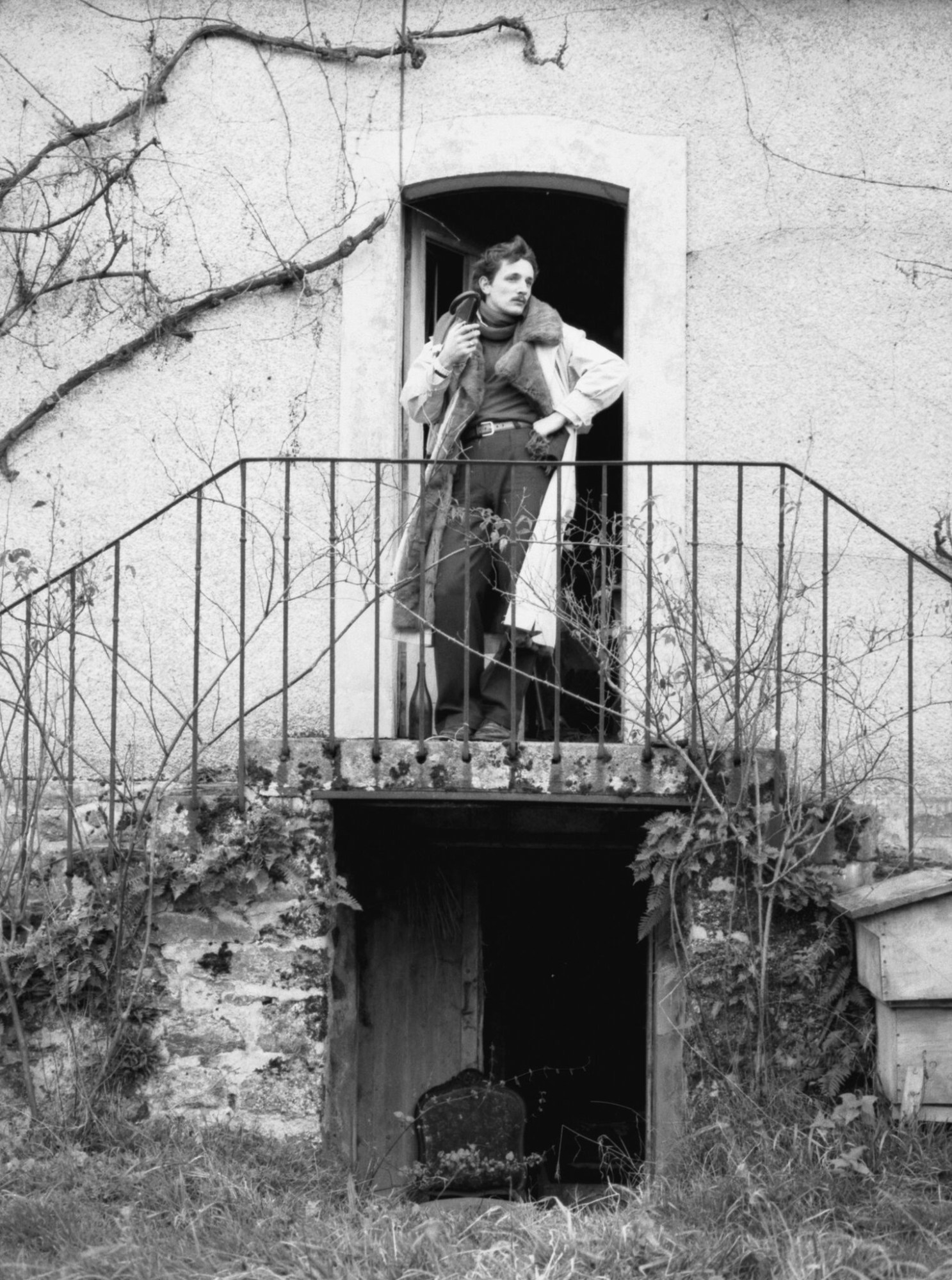This article was originally published by i-D France.
In 2008, with the release of the book Beautiful People by Alicia Drake — a formidable saga covering four decades of Parisian fashion, and chronicling the rise of Karl Lagerfeld and Yves Saint Laurent — a forgotten, angel-faced character rose from the ashes. His name was Jacques de Bascher. This sublime, irresistible dandy was Karl Lagerfeld’s partner for 18 years, and his decadent lifestyle would be his greatest achievement. He was a perverse, dark angel who seduced Yves Saint Laurent, sparking the ire of Pierre Bergé and a rift between the Lagerfeld and Saint Laurent clans. He would bury with him the era of unthinkable excess that was the late 70s and early 80s — a bygone era that is nonetheless part of fashion history, and over which Jacques de Bascher, fabulous gigolo, hovers like a bad omen. This is the character that journalist Marie Ottavi decided to investigate in her new book, published in France. Biopics like Jalil Lespert’s Yves Saint Laurent and Bertrand Bonello’s Saint Laurent painted a caricature of de Bascher, but Ottavi decided to shed new light on him. She interviewed those who knew him and interacted with him at one time or another, lifting the veil on Paris fashion’s best kept secret — and sorted out the biography of a detestable, magnetic character whose life was marked by hedonism and a lack of ambition. In his own words: “Decadence isn’t a fall, it’s a slump.”
Related: How Gaspard Ulliel Became a Drugged-Out, Volatile Yves Saint Laurent
What if Jacques de Bascher had never existed? What if he was, in the end, a fictional hero, a cross between a Proustian dandy, a sexual predator, a fashion socialite, and a witness to a bygone era — in short, a ghost? That’s the theory that author Marie Ottavi considers: “How do we go about telling the story of someone who left no traces, who did nothing with his life, who built nothing? It was an interesting challenge — first of all, because everyone told me that no one would speak to me about him, fearing the reactions of Karl Lagerfeld or Pierre Bergé, and secondly because it involved giving substance to a character that some believe had none. I remember someone telling me, ‘Why would you bother writing a book that will only be read by [approximately] 200 gays in Paris?’ That comment remained with me throughout the entire writing process. I told myself that I needed to write this book not to sell tons of copies, but to tell the story of this man. And to prove that his story holds interest for more people than one might think.”
An Irresistible Sex Symbol
“He was the classiest Frenchman I’ve ever known,” Karl Lagerfeld recalls in the book. For the first time, Lagerfeld agreed to speak at length about the man who was his partner and the only love of his life. “Jacques de Bascher, when he was young, was a devil with Garbo’s face […]. He didn’t dress like anyone; he was ahead of everyone. He made me laugh more than anyone. He was the opposite of me. He was also impossible and despicable. He was perfect. He sparked incredible cases of jealousy.” Early on, in adolescence, after seducing one of his high school teachers, de Bascher realized that his irresistible beauty and physical demeanor, which made both men and women swoon, were an invaluable weapon in a world that celebrates perfection. These assets would open all the doors that would otherwise have been closed to him. “When he realized that he had an upper hand over others,” explains Ottavi, “He saw an opportunity, and knew that things would always work out for him thanks to his personality and beauty.”
A Worldly Predator
The beautiful, young, cultured, intelligent, well-mannered, and well-clothed de Bascher — who, at some point, traded in his preppy look for a highly sophisticated wardrobe — easily made a name for himself among the frivolous, wealthy, trendy elite of the time. In the 1970s, he hung out at the Café de Flore, a hot spot for the intelligentsia at the time, as well as a lair for gigolos, and at 7, a gay club on Rue Sainte-Anne opened by Fabrice Emaer (who would become famous, years later, for creating the nightclub Palace), where different social classes intermingled — rich or poor, gay or straight, old and rich or young and penniless. At the 7, de Bascher quickly became part of the nightlife and fashion jet set. He made friends with Warhol’s entourage, which spent time in Paris, and then gravitated around Karl Lagerfeld and Yves Saint Laurent and their retinue of creatures — stunning men and women whose lives consisted of being beautiful, dancing, laughing, dressing well, and of course, doing drugs and fucking, fucking, and fucking some more…
A Proustian Dandy
“Jacques de Bascher was the archetype of a dandy, almost to the point of caricature. His indifference towards the world was of spectacular proportions. While he operated within society, he made sure never to succumb to its obligations. Money, work, and ordinary realities were not among his preoccupations,” writes Ottavi. De Bascher’s encounter with Lagerfeld — who, at the time, was not yet the kaiser of fashion he would later become — would seal his destiny, as well as enable his idleness and his marked hedonism. Very quickly, Lagerfeld became crazy about him and made him his muse. For 18 years, de Bascher and Lagerfeld would make for a strange, ultra-modern couple, an unsinkable duo who left sex out of the picture (Lagerfeld asserts that they never slept together), who made no room for jealousy or possessiveness, and who operated under the motto “he who has the money pays,” to use Lagerfeld’s elegant turn of phrase. “Who still says things like this today?” asks Ottavi. “Karl is not a socialist, and he has said so many times, but I know very few leftists with that much generosity!”
An Insatiable Man of Pleasure
Sex played a major role in de Bascher’s life. He liked to fuck both men and women, and didn’t hold back. The era was all about sexual liberation anyway, with the advent of the birth control pill, feminism, and gay liberation. He was never an activist, but at a time when many hid behind beards, he left no doubts as to his homosexuality. He laid it all out on the table, and found it amusing to shock others during worldly dinners by extolling his conquests. “He needed to have them all in his net,” explains Ottavi. “The cop, the defrocked priest, the tennis player, the mustachioed actor, the squire from the equestrian club and the entire fire station.” He flirted with others openly in the street and organized orgies at his place, where the mirrors of a shiny new Harley Davidson were turned up in order to serve as surfaces for snorting coke. He could frequently be spotted in the darkrooms that emerged in Paris during that era. He boarded a Concorde plane to go fuck at the Mineshaft in New York, the gay sex club where Cruising was shot, and where he met Michel Foucault. He liked the bourgeois set as much as the thugs; he’d be as likely to go for a Tom Selleck with a thick mustache as a married cop who just slipped him a fine.
Who can blame de Bascher for shamelessly embracing the era’s sexual permissiveness? What he did not know, however, was that it would lead him to his own death, in the form of the HIV virus that began appearing in the gay community in the early 80s. He died in 1989, at the age of 48. His name would be added to a growing list of early victims. Towards the end, he cut himself off from everything, unable to bear his physical decline. But Lagerfeld never left his side, and would never really recover from his disappearance.
A Narcissistic Pervert
Early on, sex became not just a matter of pleasure for de Bascher, but a means to tighten his grip on others. It was a perverse game that took on many forms, pushing the limits of provocation. His Black Moratorium evening is one example: On October 24, 1977, 1,500 people, each more snobbish than the other, all decked out in the requested and “absolutely mandatory tragic black outfit,” witnessed the first worldly fist-fucking in history. “He was a pervert,” comments one witness in the book. “He also had a perverted physique that said it all.” De Bascher liked decadence in all its splendor, whether it came in the shape of drugs, sex, or alcohol, which he consumed daily and immeasurably. He was fascinated by the gay S&M scene, by submissive relationships, by sex as a tool for gaining power. “Jacques had many lovers,” says Philippe Heurtault, a photographer who was very close to him. “But I wonder if sex was more important than that. Conquest was the real purpose. The more something was out of reach, the more it excited him.” It was likely this penchant for transgression that would lead him to seduce and become Yves Saint Laurent’s lover, causing the jealousy between Bergé and Lagerfeld, which had been simmering for years, to finally bubble up to the surface. The world of fashion, which once joyously hugged, fucked, and danced as one, was forced apart into two camps that now hated each other. De Bascher signed off, his middle finger in the air, just as this uninhibited, shameless bubble was about to burst, and this bygone era, which was dancing atop a volcano, would be forced to contend with the eruption of AIDS. In the words of one witness: “Our universe became dark, obscure, negative. Our lives became veiled in shadow. There had been too much sex, too much freedom, too many drugs, too much partying.” And the party had to end.
Marie Ottavi, Jacques de Bascher, dandy de l’ombre (Editions Séguier)



Credits
Text Patrick Thévenin
Translation Noémie Bonnet
